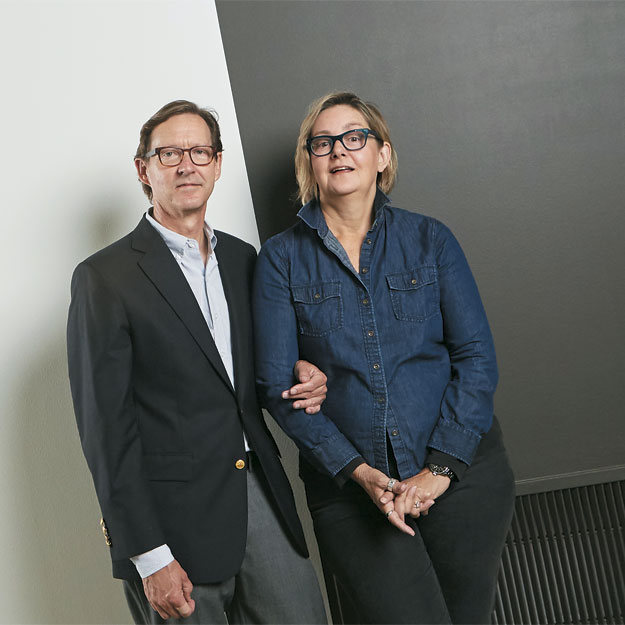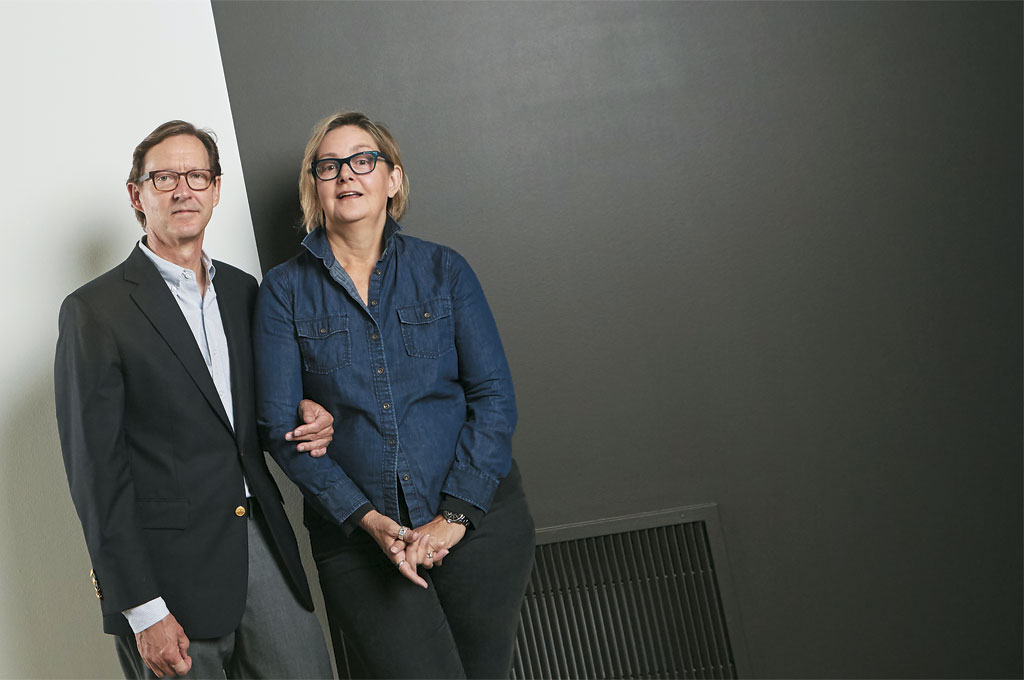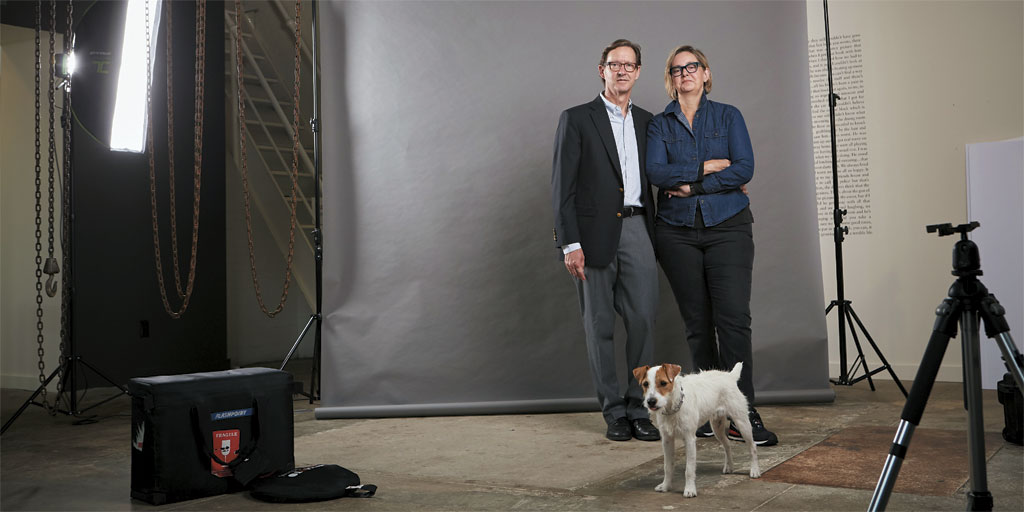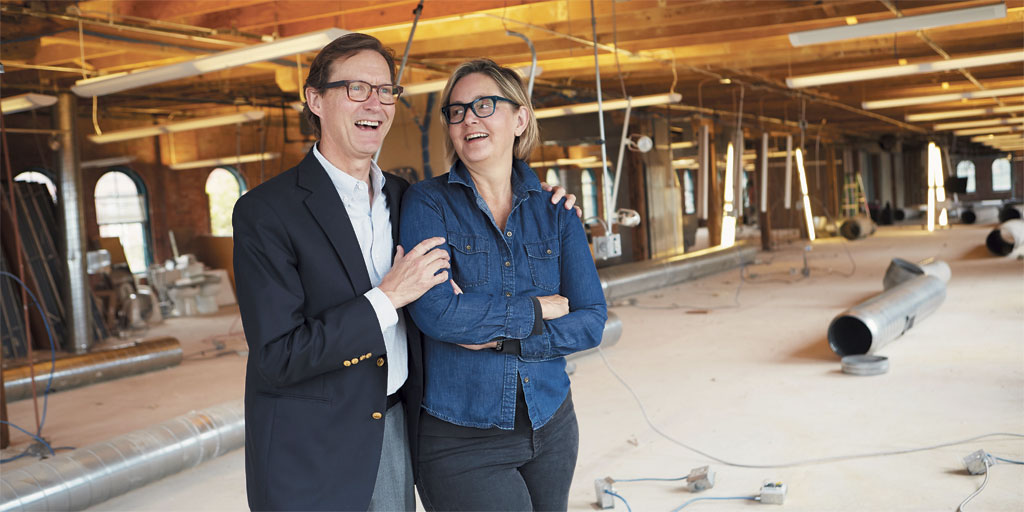A long-legged bug is pacing back and forth on Fred Bidwell’s shirt collar. But as he stands across the street from Rising Star Coffee Roasters, he doesn’t seem to notice.
Behind him, the two-story, red-brick Striebinger Block building is alive with tidy storefronts. Activity spills out onto the sidewalk. Two suits make chitchat as they sip from their cups outside Cleveland Tea Revival. A few yards away, a bearded and tattooed man enjoys a snack he picked up inside Beet Jar Juice Bar and Takeaway next door. Across the street, a “Loitering Prohibited” sign seems forgotten in a different era.
This crossroad, at West 29th Street and Church Avenue, is the heart of Hingetown, as much neighborhood as it is an emerging brand. Located on the near West Side, it’s not quite Ohio City but not yet Detroit Shoreway. It’s gritty, hip and happening — and he and his wife, Laura, are big reasons why.
“Maybe I’m getting a little ahead of the trend here,” says Fred, who built a successful advertising career and expansive art collection on such foresight. “As successful as University Circle has been, that feels sort of establishment. The West Side is feeling entrepreneurial, younger, more cutting edge. I love that dynamic.”
In dress slacks and horned-rimmed glasses, the 63-year-old looks less like the guy who started in Malone Advertising’s art department with hipster dreams of being a fine art photo-grapher and more like one who was destined to rise up its ranks to be president of the Akron firm. But Fred’s success has always been due to his ability to not only ride the cultural wave, but chart where it will crest.
Five years ago, when the Bidwells were looking for space to house their more-than-800-piece art collection, this tiny neighborhood looked very different. Rising Star was an abandoned fire station. The Striebinger Block housed three gay bars, a head shop and a rarely open barbecue restaurant. Drugs and prostitutes were the marquee attractions.
But they saw potential in the vision of Graham Veysey and his then-fiancee, Marika Shioiri-Clark, who painted a picture of what this place could be. Where a storefront was being used for storage, Veysey and Clark saw the Kutya Rev Ohio City Dog Haven. Where one window housed a bail bondsman sign, they envisioned Cleveland Tea Revival.
“What we wanted to do [in Hingetown] was create a destination with a unique identity,” says Veysey. “It wasn’t creating something new but shining some light on a part of the neighborhood that nobody had focused on for a long time.”
The Bidwells bought in, paying $160,000 for a 1920s power station and turning it into a contemporary art gallery. Through a partnership with the Cleveland Museum of Art, where Fred is a trustee, the Transformer Station has since become a cultural magnet attracting valuable eyes and wallets to Hingetown.
The gallery’s front lawn is now the de facto town square. During Cleveland Flea Sunday markets, when the neighborhood becomes a sea of vendors hawking food, jewelry and handmade soaps, the grassy patch is the designated picnic area.
“People have adopted this neighborhood because they feel like they have ownership — it’s authentic,” Fred says. “People believe it’s real. It’s not a fake thing.”
In June, the Bidwells proved just how real by purchasing the Van Roy Building across Detroit Avenue from the Striebinger Block. And by next summer, they won’t just be boosters anymore. They’ll be residents, living on the third floor of the Romanesque revival structure that will house first-floor retail and second-floor office space.
And that’s just the beginning. The Bidwells’ strategy goes beyond a single building. By buying strategic real estate, they hope to tie together the near West Side neighborhoods. In May, Fred became co-chair of the board of trustees at the Gordon Square Arts District, a perch from which he hopes to connect Gordon Square assets such as Cleveland Public Theatre, Battery Park and the Capitol Theatre with Hingetown.
“Hingetown is this interesting phenomenon, because two or three years ago it was nothing. It was nowhere in Cleveland,” Fred says. “Now it’s somewhere.”
At Oberlin College, Fred was an art history major — the closest thing to studio art for which his parents would still chip in.
“I wanted to be a fine art photographer,” he says. “But you can’t just do that. There has to be a way of, like, eating.”
Instead, he worked as a industrial photographer for Gilford Instrument Laboratories, a medical electronics firm.
In 1976, one of his fine art photographs — he can’t remember of what — managed to nab a special mention at the Cleveland Museum of Art’s now defunct May Show. He was one of 54 exhibitors — in just the photography section.
Fred needed a change. Out of desperation, he talked himself into a job as the third man in a two-man advertising firm in Warren. In 1982, when the commute from Oberlin got to be too much, he landed a job at Malone Advertising in Akron.
But as he began to work as a designer, Fred had a little trouble. “I did not know how to draw worth a rat’s ass,” he says, only half-joking.
“That [job] was my lucky break in so many ways,” he says.
It was at Malone that he met Laura Ellen Ruth.
“Laura, she’s very nice,” he says. “But I’m sure she was thinking at the time, Why the hell did they hire this guy, this no-talent?”
What Fred lacked in artistic ability, he made up for with a knack for guiding clients toward tomorrow’s trends. “I got involved with clients and the ideas behind projects,” he recalls. “That was the key.”
Laura, on the other hand, had always surrounded herself with art. Her mother, a layout artist, would paint with her toddler on her hip, lecturing on composition as she worked. Her father was a copywriter at Malone.
So when Laura enrolled in the University of Akron’s studio art program, creativity flowed naturally as blood.
During one summer, she took a job as a portrait artist. But her fascination with drawing the human face, trying to capture every contour, was a bit of a handicap. “It took me almost an hour because I would get so involved that it wasn’t so successful,” she says.
After school, Laura took a Christmas break job at O’Neil’s department store in downtown Akron selling junior sportswear. She worked the night shift in central receiving, tagging merchandise. Then, she moved to public relations, sorting customer comment cards, before being promoted to the advertising department. In 1977, Laura moved across the street to Malone.
There, she cut and pasted, laid out campaigns by hand and put her drawing skill to use. When the first Macintosh computer showed up in the office in 1984, she put her name on the sign-up list to try her hand at digital design.
“I was perfectly happy to keep rendering type and drawing,” says Laura.
Her creative output was constant. Once, for Oscars season, she sketched dress designs for all the women in the office. She made her cubicle into a destination, a large-scale collage of sorts. From floor to ceiling it was plastered with posters from Iggy Pop, Patti Smith and the Clash, scraps from magazines and postcards.
“Like most artists, I’m ripping things and clipping things constantly,” says Laura. “There was inspiration all around.”
The cubicle next door wasn’t nearly as cool. Except for the tall, lean go-getter in it, it was damn near empty.
One day, Laura popped her head over Fred’s cubicle wall.
“Lunch?” she asked him.




